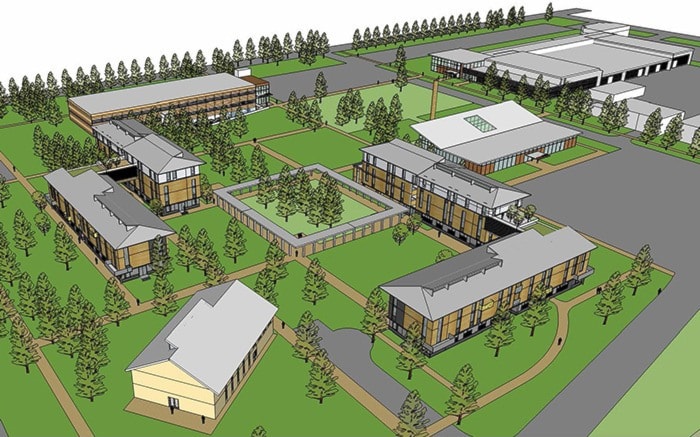WORK hasn’t even started on the $18.5 million renovation of its trades building, but Northwest Community College is already planning its next major capital projects which, based on concepts under discussion, will radically transform the campus location on the bench.
It’ll take two phases, says college president Ken Burt, but the overall result will be tearing down existing residences, most of the office buildings, and the looming two-storey food services structure.
In their place will be new residence buildings and a new instructional support and student services building – the latter immediately adjacent to the totem pole now in place between the two existing parking lots.
And all will be placed around a large open commons green space.
Crucially, says Burt, the new campus design means the college’s longhouse building, now tucked away in a far off corner behind the existing residence buildings, will emerge as a focal point bordering on the planned commons open area.
“It’s a beautiful building,” noted Burt.
There’s no timeline set for the two phases but the first one, better residences, falls in line with the provincial government’s desire to improve or add to student accommodations at post secondary institutions across the north, he said.
“We have a business case before the province,” commented Burt. The projected cost is $34 million.
Burt said new residences will fill two needs – modern facilities to attract Canadian students, mostly First Nations ones from remote communities, and to provide an incentive as the college ramps up its goal of attracting foreign students.
“The current facilities, built in the 1970s, just aren’t adequate,” Burt said.
Lack of residence space coupled with inadequate facilities was felt in the past several years when Terrace went through a rental accommodation crunch because of increased economic activity.
“We now have a tremendous opportunity,” said Burt of the college’s residence renewal plan.
“What we have is the capacity for students but no place for students to live when they are going to school.”
New campus facilities will add vibrancy to the social and academic lives of students, Burt added.
The next phase involves tearing down the existing food services building, a wooden structure which Burt says is rapidly coming to the end of its useful life.
It now has several functions, chiefly the home of the college’s culinary arts program and through that, acting as a cafeteria for staff and students. The bottom, for the moment, has a students’ union office.
The building will be replaced by an instructional and student support building, something still in the concept phase and which Burt said could cost in the neighbourhood of $30 million.
The building plans are to be part and parcel of a strategic college plan now being updated.
“This is all part of how we fit into the world of post secondary education,” said Burt.
Other highlights
The longhouse
The most recent structure to be built on campus, the longhouse was originally planned to be a key part of the college’s First Nations identity.
But it never quite fulfilled that goal, despite various attempts, although its office space has been used for administrative purposes.
“We found that it was being used just 30 times a year,” said Burt of the large open space within the building.
The current plan is to move the students’ union there and also make it more of a place for student leisure and studying.
The library
Burt admits to being surprised at the vocal reaction by students and others when plans were unveiled to redevelop the space the library occupies in the basement of its main building.
Students emphatically told college administrators at several meetings the library was a key place for studying and shouldn’t be touched.
But Burt said, when he would walk through the space, didn’t see many students there.
“It’s a little less than 10,000 square feet and I would see four or five students,” he said.
It was that utilization and the changing nature of learning away from books and papers contained in libraries to the online world that convinced college administrators a change was needed.
Already the library has been thinning out its collections of printed material
“The nature of libraries is changing and you’re going to see us next position the library for the 21st century,” said Burt.
Eventually, it and its new functions will be located in the planned new central student services and instructional building.
Foreign students
From 16 this year the goal is 40 next year.
The college now has a recruiter going far and wide, including China and Africa. The push to recruit foreign students comes from the province as one of its goals for economic growth.
“Having more foreign students expands the (course) offerings we can provide,” said Burt. “It’s a win-win.”
